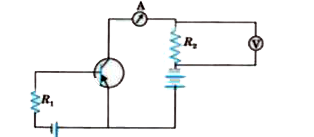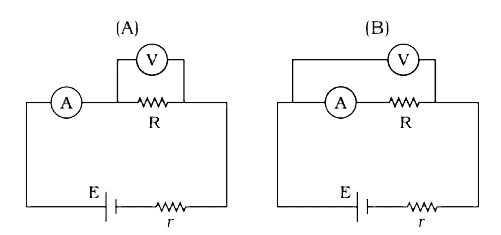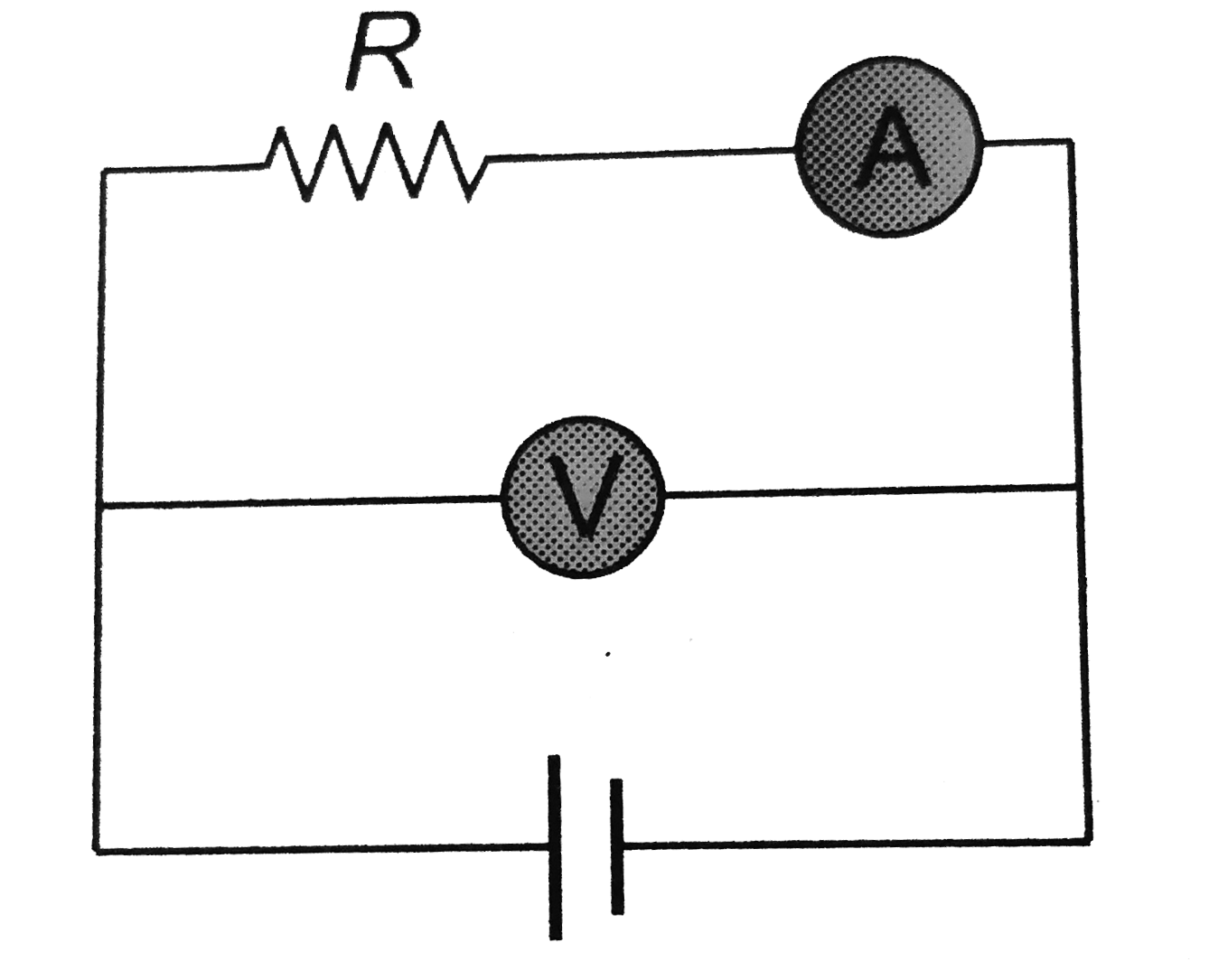Resistance of a milli ammeter is R1 of an ammeter is R2 of a voltmeter is R3 and of a kilovoltmeter is R4. Find the correct order of R1,R2,R3 and R4.
To determine the correct order of resistances R1,R2,R3, and R4 for a milliammeter, ammeter, voltmeter, and kilovoltmeter respectively, we can analyze the behavior of these instruments in terms of their resistance.
1. Understanding the Instruments:
- A milliammeter (with resistance R1) is designed to measure small currents.
- An ammeter (with resistance R2) is used to measure larger currents.
- A voltmeter (with resistance R3) measures voltage across components.
- A kilovoltmeter (with resistance R4) measures high voltages.
2. Analyzing the Resistance of the Ammeter and Milliammeter:
- To convert a galvanometer into an ammeter, a shunt resistance is placed in parallel. This shunt reduces the overall resistance of the ammeter.
- Since the milliammeter measures lower currents compared to the ammeter, it has a higher resistance. Therefore, we can conclude:
R1>R2
3. Analyzing the Resistance of the Voltmeter and Kilovoltmeter:
- To convert a galvanometer into a voltmeter, a series resistance is added. This increases the overall resistance of the voltmeter.
- A kilovoltmeter is designed to measure high voltages and thus has an even higher resistance compared to a standard voltmeter. Therefore, we can conclude:
R4>R3
4. Comparing Voltmeters and Ammeters:
- The resistance of a voltmeter is always higher than that of an ammeter because voltmeters need to minimize the current they draw to avoid affecting the circuit they are measuring. Thus:
R3>R2
5. Combining All Relationships:
- From the above deductions, we have:
- R1>R2 (milliammeter > ammeter)
- R4>R3 (kilovoltmeter > voltmeter)
- R3>R2 (voltmeter > ammeter)
- Combining these inequalities, we can derive the overall order:
R4>R3>R1>R2
Final Order:
The correct order of resistances is:
R4>R3>R1>R2
- A milliammeter (with resistance R1) is designed to measure small currents.
- An ammeter (with resistance R2) is used to measure larger currents.
- A voltmeter (with resistance R3) measures voltage across components.
- A kilovoltmeter (with resistance R4) measures high voltages.
- To convert a galvanometer into an ammeter, a shunt resistance is placed in parallel. This shunt reduces the overall resistance of the ammeter.
- Since the milliammeter measures lower currents compared to the ammeter, it has a higher resistance. Therefore, we can conclude:
R1>R2
- To convert a galvanometer into a voltmeter, a series resistance is added. This increases the overall resistance of the voltmeter.
- A kilovoltmeter is designed to measure high voltages and thus has an even higher resistance compared to a standard voltmeter. Therefore, we can conclude:
R4>R3
- The resistance of a voltmeter is always higher than that of an ammeter because voltmeters need to minimize the current they draw to avoid affecting the circuit they are measuring. Thus:
R3>R2
- From the above deductions, we have:
- R1>R2 (milliammeter > ammeter)
- R4>R3 (kilovoltmeter > voltmeter)
- R3>R2 (voltmeter > ammeter)
- Combining these inequalities, we can derive the overall order:
R4>R3>R1>R2
The correct order of resistances is:
R4>R3>R1>R2
Topper's Solved these Questions
- BOOK - DC PANDEYCHAPTER - CURRENT ELECTRICITYEXERCISE - Example Type 12videos
CURRENT ELECTRICITY
- BOOK - DC PANDEYCHAPTER - CURRENT ELECTRICITYEXERCISE - Example Type 21videos
CURRENT ELECTRICITY
- BOOK - DC PANDEYCHAPTER - COMMUNICATION SYSTEMEXERCISE - Subjective11videos
COMMUNICATION SYSTEM
- BOOK - DC PANDEYCHAPTER - ELECTROMAGNETIC INDUCTIONEXERCISE - Medical entrances gallery25videos
ELECTROMAGNETIC INDUCTION
Similar Questions
If the resistance R1 is increased how will the reading of the ammeter and voltmeter change
 View Solution
View SolutionA voltmeter of resistance RV and an ammeter of resistance RA are connected as shown in an attempt to measure the resistance R. The measured value of the resistance is RM=VI0 where V is reading of voltmeter and I0 is reading of the ammeter. find the true value of the resistance in terms of RM,RVandRA.
 View Solution
View Solution
Knowledge Check
- Question 1 - Select One
The resistance of ammeter is R0
 AIf r=0, if the value of resistance R increase, the current in ammeter will remain sameBIf r=0, if the value of resistance R decrease, the current in ammeter will remain sameCIf r≠0, if R increase, the current in ammeter will remian sameDIf r≠0, if R increases, the current in ammeter will increase
AIf r=0, if the value of resistance R increase, the current in ammeter will remain sameBIf r=0, if the value of resistance R decrease, the current in ammeter will remain sameCIf r≠0, if R increase, the current in ammeter will remian sameDIf r≠0, if R increases, the current in ammeter will increase - Question 2 - Select One
If resistance of voltmeter is 10000Ω and resistance of ammeter is 2Ω then find R when voltmeter reads 12 V and ammeter reads 0.1 A
A118ΩB120ΩC124ΩD114Ω - Question 3 - Select One
A galvanometer is to be converted into a voltmeter and an ammeter successively by using either of two resistances R1andR2(R1>R2)
AR1 in series with galvanometer and R2 in parallelBR2 in series with galvanometer and R1 in parallelCR1 in parallel with ganvanometer and R2 in seriesDR2 in parallel with galvanometer and R1 in series
A voltmeter of resistance R1 and an ammeter of resistance R2 are connected in series across a battery oif negligible internal resistance. When as resistance R is connected in parallel to voltmeter reading of ammeter increases three times white that of voltmeter reduces to one third. Find R1 and R2 in terms of R.
View SolutionResistance value of an unknown resistor is calculated using the formula R=VI where V and I be the readings of the voltmeter and the ammeter respectively. Consider the circuits below. The internal resistances of the voltmeter and the ammeter (RvandRGrespectively ) are finite and non zero.

Let RvandRG be the calculated values in the two cases A and B respectively.
If the resistance of voltmeter is Rv=1kΩ and that of ammeter is RG=1Ω the magnitude of the percentage error in the measurement of R (the value of R is nearly 10Ω ) is:View SolutionIf G, rA and rV denote the internal resistances of a galvanometer, an ammeter and a voltmeter among the following the correct relationship is
View SolutionIn the given circuit, the ratio of voltmeter reading to the ammeter reading is R'. If resistance of ammeter is RA and that of voltmeter RV, then
 View Solution
View SolutionA voltmeter and an ammeter are connected in the circuit as shown. Resistance of ammeter is say R10 and that of voltmeter is 10R. Then
 View Solution
View Solution

